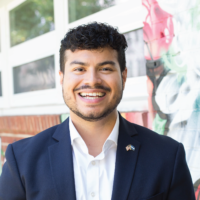May 28, 2024
Major Changes From The Conference Budget That Helped Get To A Final Budget
Families across Virginia want to live in communities with well-resourced schools, access to affordable health coverage, and state investments so we can all thrive. That’s why it is important that the final budget maintained key investments in K-12 education, the public health safety net, and more that were made in the General Assembly (GA) approved budget from March. This crucial funding was made despite the decision not to move forward with a plan to sustain and build on these investments.
The proposal to modernize our tax code by extending the sales tax to digital services and doing so in a way that made sure corporations also paid their fair share, would have created a new stream of reliable funding to ensure Virginia has more resources during this budget cycle and in future years. It would have reduced the chances of having to make difficult budget decisions down the road. Unfortunately, the new revenue stream was not included in the final budget, but the General Assembly managed to maintain critical investments in part by carrying forward “surplus” funds from the current budget year due to stronger-than-expected revenue collections, swapping cash to debt for capital projects, and capturing savings from failed legislation and reductions from mostly technical adjustments.
While we applaud the long-overdue investments in education, health care access, and more, it is clear that if Virginia is to maintain and build on these decisions, lawmakers must modernize our tax code and make sure that millionaires, billionaires, and profitable corporations pay their fair share come tax time.
While many key investments from the March budget were maintained, here are some significant changes made for the final budget signed by the governor in the areas of :
Jump to:
Tax and Revenue Changes from HB29/30
- FY24 Carryforward: Revenues from the budget year that ends June 30 (fiscal year 2024) are performing better than expected, and are ahead of forecast. As a result, revenues increased for the revised FY24 budget, also known as the caboose budget. Much of this surplus is carried forward to the FY25-26 budget, resulting in $498.7 million in additional funds for the new budget deal.
- No new economy sales tax: The governor’s introduced budget included a sales tax modernization that would expand the state sales tax to new economy products like digital downloads. In their March budget, the GA improved upon this proposal by extending the new economy sales tax to include business-to-business transactions for software application services. This proposal was a step toward updating Virginia’s tax code, and Virginia would have joined the ranks of 39 other states, DC, and some Alaska municipalities that extend their sales taxes to some digital products. Unfortunately, it was not included in the final budget. This was the largest change in revenues between the two proposals. As a result, lawmakers lost out on $1.055 billion (General Fund) to use for investment in key priorities.
- Revenue adjustments from legislation, vetoes, and amendments: The final budget included other revenue adjustments, such as a smaller revenue loss from increasing the cap on the Historic Rehabilitation Tax Credit (adding $2.5 million back in), revenue loss from the veto of retail cannabis legislation (-$23.9 million), and elimination of skill game revenue in FY25 (-$93.7 million).
- Transfer adjustments: Adjustments to transfers also reduced available General Fund resources, over which lawmakers have the most authority. Among other adjustments, $133.9 million of sales tax revenue will no longer be transferred from specific tax funds to the GF for K-12 use (a technical reduction) due to the elimination of the sales tax modernization, and the transfer of ABC net profits was reduced by $44.1 million.
K-12 Education Changes from HB29/30
- Lab School funding: The final budget directs all unspent funds from the College Partnership Laboratory Schools Fund in FY24 to revert back to the General Fund on June 30, 2024. Language is also included to allow ineligible institutions that wish to operate a lab school to partner with eligible public institutions of higher learning, so long as the eligible institution is the fiscal sponsor.
- New economy sales tax: Portions of Virginia’s sales tax are dedicated to K-12 education. Not including the sales tax modernization in the final budget means less funding for direct aid to public education than in the previous GA budget proposal (-$169 million).
- Literary Fund: The final budget authorizes up to $250 million from the Literary Fund to go toward school construction loans. Up to $150 million in FY26 has been allocated for teacher retirement.
- Reduced Virginia Preschool Initiative (VPI) utilization forecast: The budget typically assumes 20% of eligible students do not use VPI, when the actual non-use rate is higher, at around 32-33%. The final budget reduces VPI funding based on the actual enrollment figures. (-$71 million)
Health Care Changes from HB29/30
- Increase in Health Care Fund: An increase in the Health Care Fund for FY24 is expected to save the state $40 million in General Fund costs. The Health Care Fund is typically used to offset state costs to Medicaid, so any increase in the fund leads to state savings. (-$40 million)
- Reduction of Medicaid contingency fund: The final budget reduces funding set aside for any higher-than-anticipated costs associated with Medicaid enrollment and use. The March conference budget sets aside $150 million, while the final budget sets aside $95 million for the same purpose. (-$55 million)
- Smaller Increase for Medicaid Personal Care Attendants: The proposed minimum wage increase to $15 would have also raised wages for many home health care workers serving Medicaid patients. Reimbursement rates were set to increase by 1.2% in the first year and 11.1% in the second to align with the minimum wage boost, increasing state costs by nearly $64 million over the biennium. Although the governor vetoed the minimum wage bill, the final budget increases the rate by 2% each year, totaling $56 million. (-$8 million)
Criminal Legal Changes from HB29/30
- Elimination of funds for vetoed bills: The final budget reflects the governor’s actions in vetoing a number of criminal legal-related bills, including the restriction of isolated confinement in state correctional facilities, modification of sentences for marijuana-related offenses, and the discretionary use of fines and fees in youth traffic cases. (-$8.2 million)
Other
- Elimination of Regional Greenhouse Gas Initiative (RGGI) Directive: The final budget removes language that would have required Virginia to rejoin the Regional Greenhouse Gas Initiative – a nationwide program that limits power plant carbon pollution, charges power companies for pollution, and reinvests those dollars into communities. The controversy over this program began in 2022 when Governor Youngkin issued Executive Order Nine initiating Virginia’s withdrawal from RGGI. Currently, the Association of Energy Conservation Professionals has filed a lawsuit against Governor Youngkin stating that it is unlawful to withdraw from this program without approval from the General Assembly. The language included in the March budget would have affirmed Virginia’s participation in RGGI and continued to support Virginia communities through funding for energy efficiency projects and natural disaster relief programs.
- Minimum wage: Gov. Youngkin’s veto of a $15 minimum wage proposal reduced costs to the state by $79.5 million. This reduction was partially offset by the increased reimbursement rate for home health care workers mentioned above. (-$23.5 million)
Categories:
Budget & Revenue, Economic Opportunity, Education, Health Care



